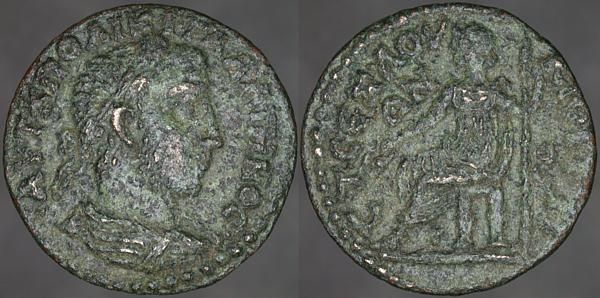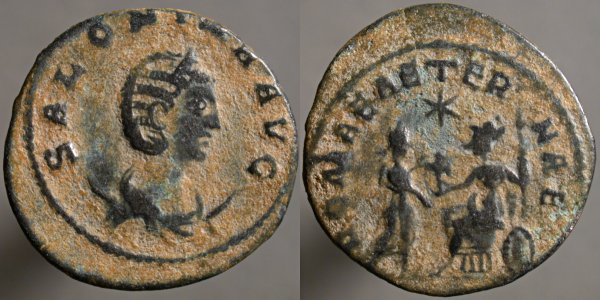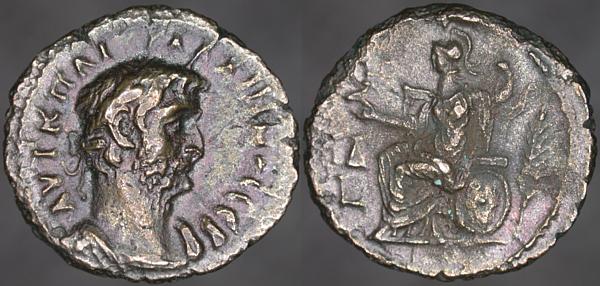Friday, November 24, 2006
Æ23, Teos in Ionia, Gallienus, SNG Copenhagen 1533

AVT K ΠO ΛIKI ΓAΛΛIHNOC, Laureate draped cuirassed bust right | CT CEZ ΛOV[KIOV THI]ΩN, Dionysus seated left, holding kantharos left and thyrsus right.
I think I skipped posting this previously because if the poor appearance, but since I am, as I write this, still not back at work and so not not buying coins, my standards are lower.
Thursday, November 23, 2006
Silvered Æ antoninianus, Salonina, Samosata, Göbl 1701t

SALONINA AVG, Diademed draped bust right on crescent | ROMAE AETERNAE,To right, Roma seated left on shield, with spear in left hand, with right hand presenting Victory to emperor, who stands to her right. Star above.
I've always been a little suspicious of dust patina or desert patina such as seen here, or of my own ability to detect a false patina, which might might be hiding some more serious flaw.
Such concerns aside, I do like the look of the surface.
Wednesday, November 22, 2006
Æ follis, Theofilus, uncertain mint, Sear 1685

[ΘEOFIL' bASIL'] Three-quarter length figure facing, holding labarum and globus cruciger | [+ΘEO] / FILE AV[ς] / OVSτE SV / hILAS, Legend in four lines.
Theophilos became emperor in 829, 264 years after the death of Justinian, my next most recent emperor. At this late date, the coins are clearly "Byzantine", little resembling their Roman predecessors.
Theophilos died of natural causes after military failures in 837.
Tuesday, November 21, 2006
Æ tetradrachn, Alexandria, Gallienus, Emmett 3797(14)

AVT K Π ΛIK ΓAΛΛIHNOC CEB, Laureate cuirassed bust right | LIΔ, Athena seated left on throne, holding spear right and Nike left, who presents wreath. Shield beneath throne right, palm in right field, regnal year in lower left.
In some ways, the coins of Roman Egypt make sense in very modern terms, in ways that most other ancient coins don't. The coins of Egypt are (nealy) always dated (with the emperor's date in office.) They use reverse designs that rarely vary with the emperor's accomplishments, but instead often are used again for centuries, perhaps a society in which change was less frequent and less desired than it was a Rome.
Monday, November 20, 2006
Billon antoninianus, Gallienus, Cyzikus, Göbl 1547Ac

GALLIENVS AVG, Radiate draped cuirassed bust right, no pellets beneath | SALVS AVG, Salus standing right, holding snake in right arm, feeding it from small patera held in left hand. SPQR in exergue.
As is often going to be true for coins I post during my purchasing hiatus, this is a duplicate of a coin that I did post, although I think today's example may be nicer than that I posted in 2004. Unlike in our culture, in Rome the snake was, by default, a positive symbol, representative of Salus, a diety of preservation or restoration of health.
I feel a bit of personal attachment to Salus.

